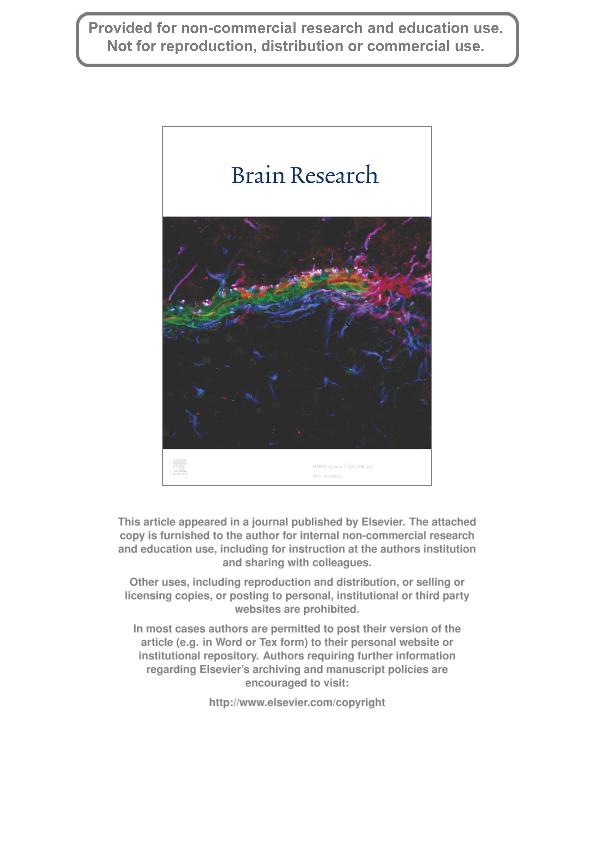Mostrar el registro sencillo del ítem
dc.contributor.author
Castañeda, Mauricio Martin

dc.contributor.author
Cubilla, Marisa Angélica

dc.contributor.author
López Vicchi, Martín Miguel

dc.contributor.author
Suburo, Angela Maria

dc.date.available
2020-03-05T15:09:38Z
dc.date.issued
2010-03
dc.identifier.citation
Castañeda, Mauricio Martin; Cubilla, Marisa Angélica; López Vicchi, Martín Miguel; Suburo, Angela Maria; Endothelinergic cells in the subependymal region of mice; Elsevier Science; Brain Research; 1321; 3-2010; 20-30
dc.identifier.issn
0006-8993
dc.identifier.uri
http://hdl.handle.net/11336/98834
dc.description.abstract
Endothelin (ET) is a small peptide that activates astrocyte proliferation, regulates proliferation and migration of embryonic neural precursor cells and stimulates glioblastoma growth. We found that in mouse brain, ET and its receptor B (ETRB) were highly expressed in the subependymal zone (SEZ), an adult neurogenic niche. Cells with ET immunoreactivity (ET+ cells) selectively appeared along the lateral and dorsal walls of the lateral ventricle. They also appeared in the cingular region of the corpus callosum. Subependymal ET+ cells also displayed prominin (PRO), glial fibrillary acidic protein (GFAP) and ETRB immunoreactivities. ET+ processes traversed the ependymal epithelium and approached the ventricular lumen. Ependymal cells only showed ETRB-ir. A small but consistent number of ET+ cells displayed proliferation markers: 5-bromo-2′-deoxyuridine (BrdU) incorporation, and minichromosome maintenance protein 2 (Mcm2). Cortical injury and G-CSF increased subependymal endothelinergic cells and their proliferation markers. Our findings suggest that ET and ETRB might be associated with regulation of adult neural stem cells and their migration through neurogenic and gliogenic pathways.
dc.format
application/pdf
dc.language.iso
eng
dc.publisher
Elsevier Science

dc.rights
info:eu-repo/semantics/openAccess
dc.rights.uri
https://creativecommons.org/licenses/by-nc-sa/2.5/ar/
dc.subject
ADULT NEUROGENESIS
dc.subject
ASTROCYTE
dc.subject
CINGULUM
dc.subject
ENDOTHELIN
dc.subject
GRANULOCYTE-COLONY STIMULATING FACTOR
dc.subject
NEURAL STEM CELL
dc.subject
STROKE
dc.subject
SUBEPENDYMAL ZONE
dc.subject
SUBVENTRICULAR ZONE
dc.subject
TRAUMATIC BRAIN INJURY
dc.subject.classification
Neurociencias

dc.subject.classification
Medicina Básica

dc.subject.classification
CIENCIAS MÉDICAS Y DE LA SALUD

dc.title
Endothelinergic cells in the subependymal region of mice
dc.type
info:eu-repo/semantics/article
dc.type
info:ar-repo/semantics/artículo
dc.type
info:eu-repo/semantics/publishedVersion
dc.date.updated
2020-03-04T17:33:30Z
dc.journal.volume
1321
dc.journal.pagination
20-30
dc.journal.pais
Países Bajos

dc.journal.ciudad
Amsterdam
dc.description.fil
Fil: Castañeda, Mauricio Martin. Consejo Nacional de Investigaciones Científicas y Técnicas; Argentina. Universidad Austral. Facultad de Ciencias Biomédicas; Argentina
dc.description.fil
Fil: Cubilla, Marisa Angélica. Consejo Nacional de Investigaciones Científicas y Técnicas; Argentina. Universidad Austral. Facultad de Ciencias Biomédicas; Argentina
dc.description.fil
Fil: López Vicchi, Martín Miguel. Universidad Austral. Facultad de Ciencias Biomédicas; Argentina
dc.description.fil
Fil: Suburo, Angela Maria. Consejo Nacional de Investigaciones Científicas y Técnicas; Argentina. Universidad Austral. Facultad de Ciencias Biomédicas; Argentina
dc.journal.title
Brain Research

dc.relation.alternativeid
info:eu-repo/semantics/altIdentifier/url/hhttps://www.sciencedirect.com/science/article/pii/S0006899310002106
dc.relation.alternativeid
info:eu-repo/semantics/altIdentifier/doi/http://dx.doi.org/10.1016/j.brainres.2010.01.056
Archivos asociados
